Information Management and Strategic Decision-Making Report - Module
VerifiedAdded on 2023/01/06
|14
|4706
|77
Report
AI Summary
This report delves into the critical role of information management in strategic decision-making. It begins by explaining the importance of management information, identifying key features of data and information, and establishing criteria for selecting appropriate data to support strategic choices. The report then evaluates the impact of Management Information Systems (MIS) on organizations. It also addresses the legal responsibilities associated with sourcing, sharing, and storing information, including when and how information access should be granted, and the impact of various information formats. Furthermore, the report analyzes how information can be critically analyzed to identify patterns, trends, and impacts on strategic decisions, including the evaluation of decision-making tools and techniques, and the identification of data sources. Finally, the report explores methods for evaluating management information, formulating processes for analyzing information impact, and developing information capture strategies to support effective strategic decision-making. The report covers all aspects of information management and its impact on strategic decision-making.
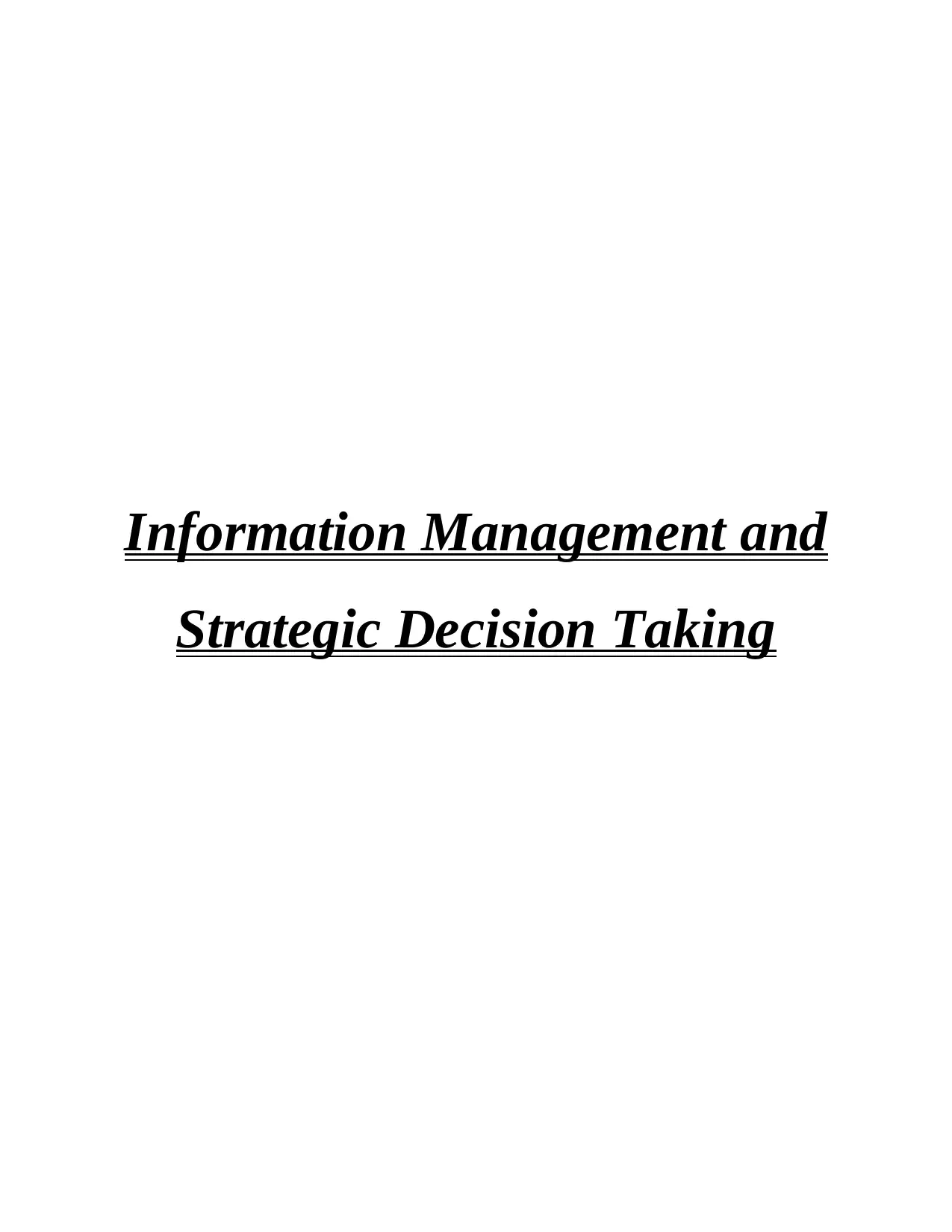
Information Management and
Strategic Decision Taking
Strategic Decision Taking
Paraphrase This Document
Need a fresh take? Get an instant paraphrase of this document with our AI Paraphraser
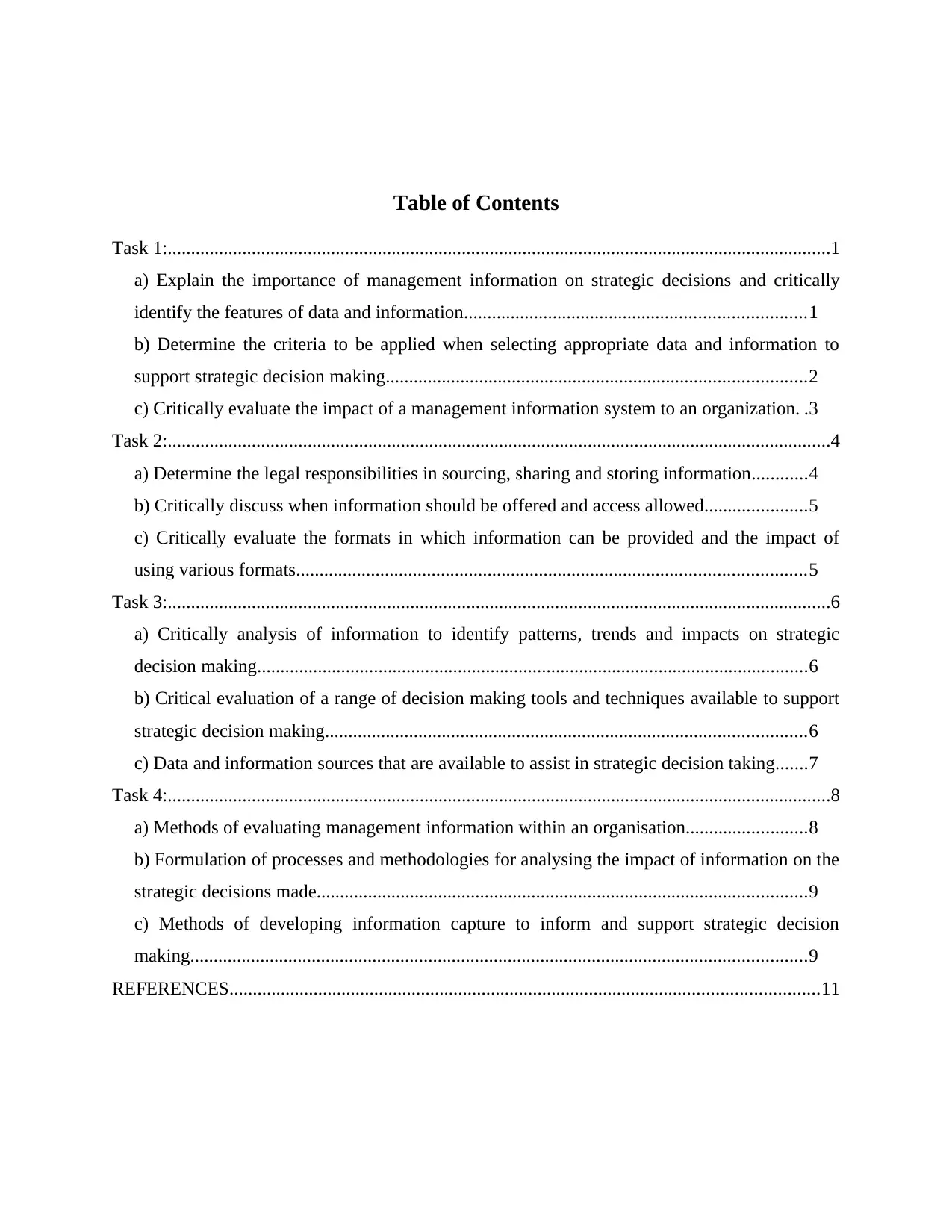
Table of Contents
Task 1:..............................................................................................................................................1
a) Explain the importance of management information on strategic decisions and critically
identify the features of data and information.........................................................................1
b) Determine the criteria to be applied when selecting appropriate data and information to
support strategic decision making..........................................................................................2
c) Critically evaluate the impact of a management information system to an organization. .3
Task 2:..............................................................................................................................................4
a) Determine the legal responsibilities in sourcing, sharing and storing information............4
b) Critically discuss when information should be offered and access allowed......................5
c) Critically evaluate the formats in which information can be provided and the impact of
using various formats.............................................................................................................5
Task 3:..............................................................................................................................................6
a) Critically analysis of information to identify patterns, trends and impacts on strategic
decision making......................................................................................................................6
b) Critical evaluation of a range of decision making tools and techniques available to support
strategic decision making.......................................................................................................6
c) Data and information sources that are available to assist in strategic decision taking.......7
Task 4:..............................................................................................................................................8
a) Methods of evaluating management information within an organisation..........................8
b) Formulation of processes and methodologies for analysing the impact of information on the
strategic decisions made.........................................................................................................9
c) Methods of developing information capture to inform and support strategic decision
making....................................................................................................................................9
REFERENCES..............................................................................................................................11
Task 1:..............................................................................................................................................1
a) Explain the importance of management information on strategic decisions and critically
identify the features of data and information.........................................................................1
b) Determine the criteria to be applied when selecting appropriate data and information to
support strategic decision making..........................................................................................2
c) Critically evaluate the impact of a management information system to an organization. .3
Task 2:..............................................................................................................................................4
a) Determine the legal responsibilities in sourcing, sharing and storing information............4
b) Critically discuss when information should be offered and access allowed......................5
c) Critically evaluate the formats in which information can be provided and the impact of
using various formats.............................................................................................................5
Task 3:..............................................................................................................................................6
a) Critically analysis of information to identify patterns, trends and impacts on strategic
decision making......................................................................................................................6
b) Critical evaluation of a range of decision making tools and techniques available to support
strategic decision making.......................................................................................................6
c) Data and information sources that are available to assist in strategic decision taking.......7
Task 4:..............................................................................................................................................8
a) Methods of evaluating management information within an organisation..........................8
b) Formulation of processes and methodologies for analysing the impact of information on the
strategic decisions made.........................................................................................................9
c) Methods of developing information capture to inform and support strategic decision
making....................................................................................................................................9
REFERENCES..............................................................................................................................11
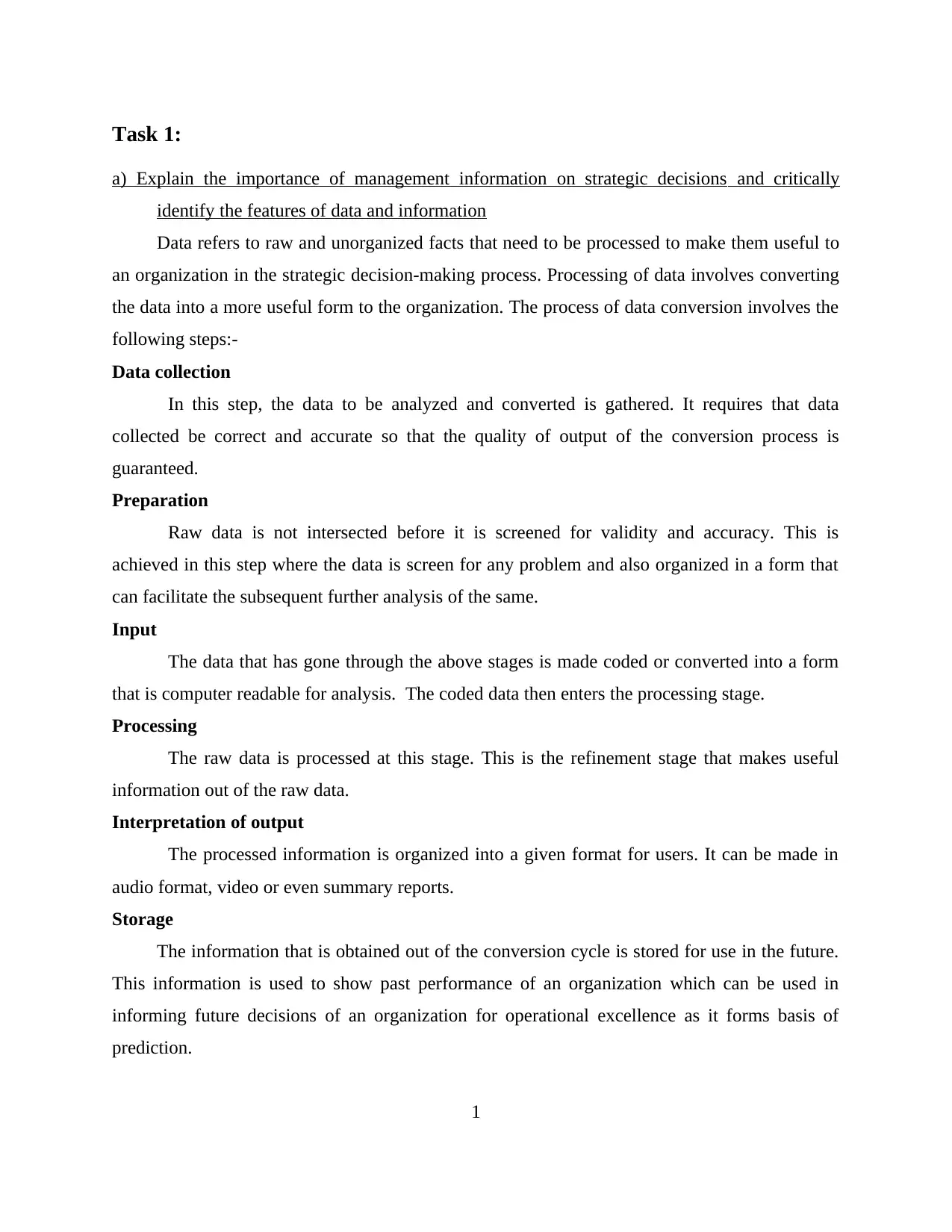
Task 1:
a) Explain the importance of management information on strategic decisions and critically
identify the features of data and information
Data refers to raw and unorganized facts that need to be processed to make them useful to
an organization in the strategic decision-making process. Processing of data involves converting
the data into a more useful form to the organization. The process of data conversion involves the
following steps:-
Data collection
In this step, the data to be analyzed and converted is gathered. It requires that data
collected be correct and accurate so that the quality of output of the conversion process is
guaranteed.
Preparation
Raw data is not intersected before it is screened for validity and accuracy. This is
achieved in this step where the data is screen for any problem and also organized in a form that
can facilitate the subsequent further analysis of the same.
Input
The data that has gone through the above stages is made coded or converted into a form
that is computer readable for analysis. The coded data then enters the processing stage.
Processing
The raw data is processed at this stage. This is the refinement stage that makes useful
information out of the raw data.
Interpretation of output
The processed information is organized into a given format for users. It can be made in
audio format, video or even summary reports.
Storage
The information that is obtained out of the conversion cycle is stored for use in the future.
This information is used to show past performance of an organization which can be used in
informing future decisions of an organization for operational excellence as it forms basis of
prediction.
1
a) Explain the importance of management information on strategic decisions and critically
identify the features of data and information
Data refers to raw and unorganized facts that need to be processed to make them useful to
an organization in the strategic decision-making process. Processing of data involves converting
the data into a more useful form to the organization. The process of data conversion involves the
following steps:-
Data collection
In this step, the data to be analyzed and converted is gathered. It requires that data
collected be correct and accurate so that the quality of output of the conversion process is
guaranteed.
Preparation
Raw data is not intersected before it is screened for validity and accuracy. This is
achieved in this step where the data is screen for any problem and also organized in a form that
can facilitate the subsequent further analysis of the same.
Input
The data that has gone through the above stages is made coded or converted into a form
that is computer readable for analysis. The coded data then enters the processing stage.
Processing
The raw data is processed at this stage. This is the refinement stage that makes useful
information out of the raw data.
Interpretation of output
The processed information is organized into a given format for users. It can be made in
audio format, video or even summary reports.
Storage
The information that is obtained out of the conversion cycle is stored for use in the future.
This information is used to show past performance of an organization which can be used in
informing future decisions of an organization for operational excellence as it forms basis of
prediction.
1
⊘ This is a preview!⊘
Do you want full access?
Subscribe today to unlock all pages.

Trusted by 1+ million students worldwide
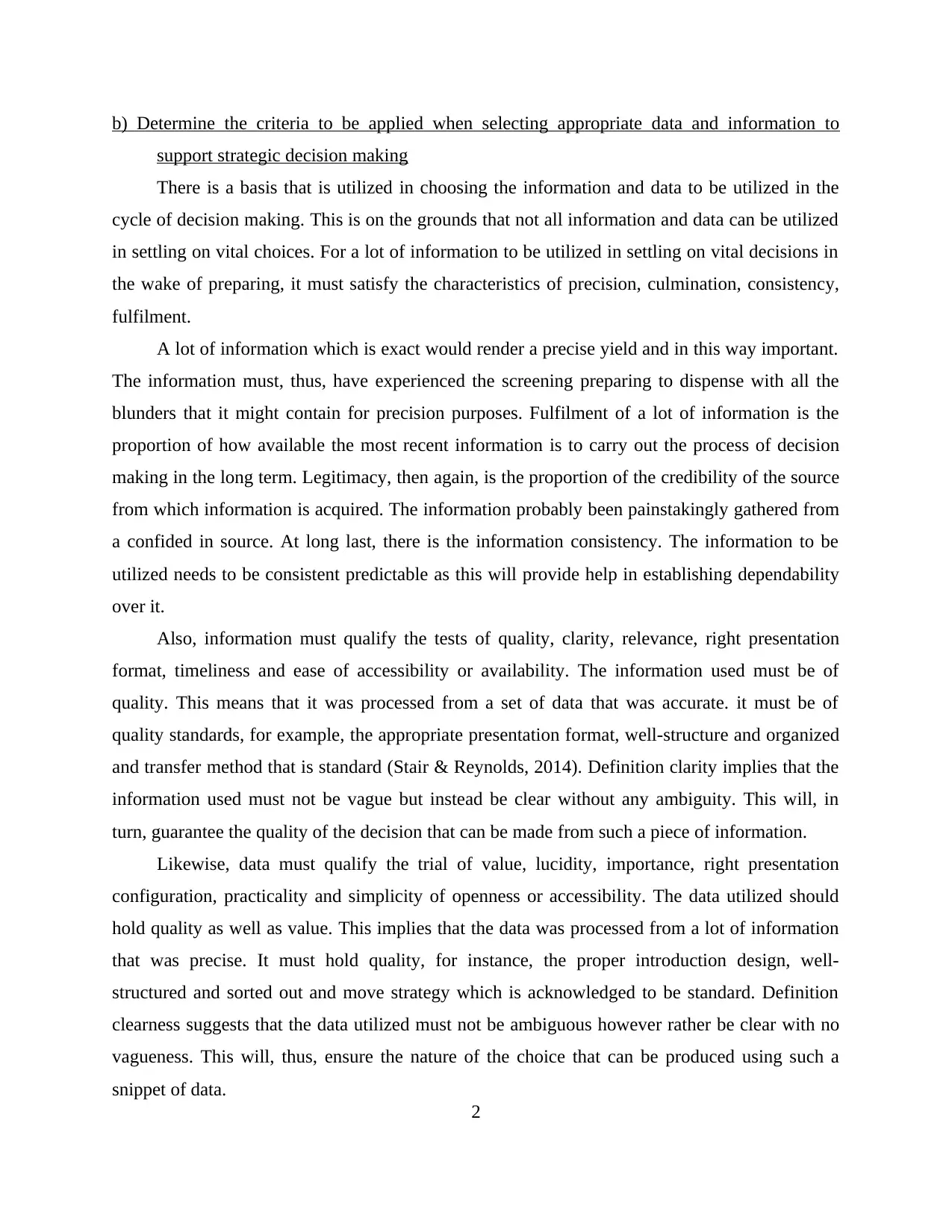
b) Determine the criteria to be applied when selecting appropriate data and information to
support strategic decision making
There is a basis that is utilized in choosing the information and data to be utilized in the
cycle of decision making. This is on the grounds that not all information and data can be utilized
in settling on vital choices. For a lot of information to be utilized in settling on vital decisions in
the wake of preparing, it must satisfy the characteristics of precision, culmination, consistency,
fulfilment.
A lot of information which is exact would render a precise yield and in this way important.
The information must, thus, have experienced the screening preparing to dispense with all the
blunders that it might contain for precision purposes. Fulfilment of a lot of information is the
proportion of how available the most recent information is to carry out the process of decision
making in the long term. Legitimacy, then again, is the proportion of the credibility of the source
from which information is acquired. The information probably been painstakingly gathered from
a confided in source. At long last, there is the information consistency. The information to be
utilized needs to be consistent predictable as this will provide help in establishing dependability
over it.
Also, information must qualify the tests of quality, clarity, relevance, right presentation
format, timeliness and ease of accessibility or availability. The information used must be of
quality. This means that it was processed from a set of data that was accurate. it must be of
quality standards, for example, the appropriate presentation format, well-structure and organized
and transfer method that is standard (Stair & Reynolds, 2014). Definition clarity implies that the
information used must not be vague but instead be clear without any ambiguity. This will, in
turn, guarantee the quality of the decision that can be made from such a piece of information.
Likewise, data must qualify the trial of value, lucidity, importance, right presentation
configuration, practicality and simplicity of openness or accessibility. The data utilized should
hold quality as well as value. This implies that the data was processed from a lot of information
that was precise. It must hold quality, for instance, the proper introduction design, well-
structured and sorted out and move strategy which is acknowledged to be standard. Definition
clearness suggests that the data utilized must not be ambiguous however rather be clear with no
vagueness. This will, thus, ensure the nature of the choice that can be produced using such a
snippet of data.
2
support strategic decision making
There is a basis that is utilized in choosing the information and data to be utilized in the
cycle of decision making. This is on the grounds that not all information and data can be utilized
in settling on vital choices. For a lot of information to be utilized in settling on vital decisions in
the wake of preparing, it must satisfy the characteristics of precision, culmination, consistency,
fulfilment.
A lot of information which is exact would render a precise yield and in this way important.
The information must, thus, have experienced the screening preparing to dispense with all the
blunders that it might contain for precision purposes. Fulfilment of a lot of information is the
proportion of how available the most recent information is to carry out the process of decision
making in the long term. Legitimacy, then again, is the proportion of the credibility of the source
from which information is acquired. The information probably been painstakingly gathered from
a confided in source. At long last, there is the information consistency. The information to be
utilized needs to be consistent predictable as this will provide help in establishing dependability
over it.
Also, information must qualify the tests of quality, clarity, relevance, right presentation
format, timeliness and ease of accessibility or availability. The information used must be of
quality. This means that it was processed from a set of data that was accurate. it must be of
quality standards, for example, the appropriate presentation format, well-structure and organized
and transfer method that is standard (Stair & Reynolds, 2014). Definition clarity implies that the
information used must not be vague but instead be clear without any ambiguity. This will, in
turn, guarantee the quality of the decision that can be made from such a piece of information.
Likewise, data must qualify the trial of value, lucidity, importance, right presentation
configuration, practicality and simplicity of openness or accessibility. The data utilized should
hold quality as well as value. This implies that the data was processed from a lot of information
that was precise. It must hold quality, for instance, the proper introduction design, well-
structured and sorted out and move strategy which is acknowledged to be standard. Definition
clearness suggests that the data utilized must not be ambiguous however rather be clear with no
vagueness. This will, thus, ensure the nature of the choice that can be produced using such a
snippet of data.
2
Paraphrase This Document
Need a fresh take? Get an instant paraphrase of this document with our AI Paraphraser
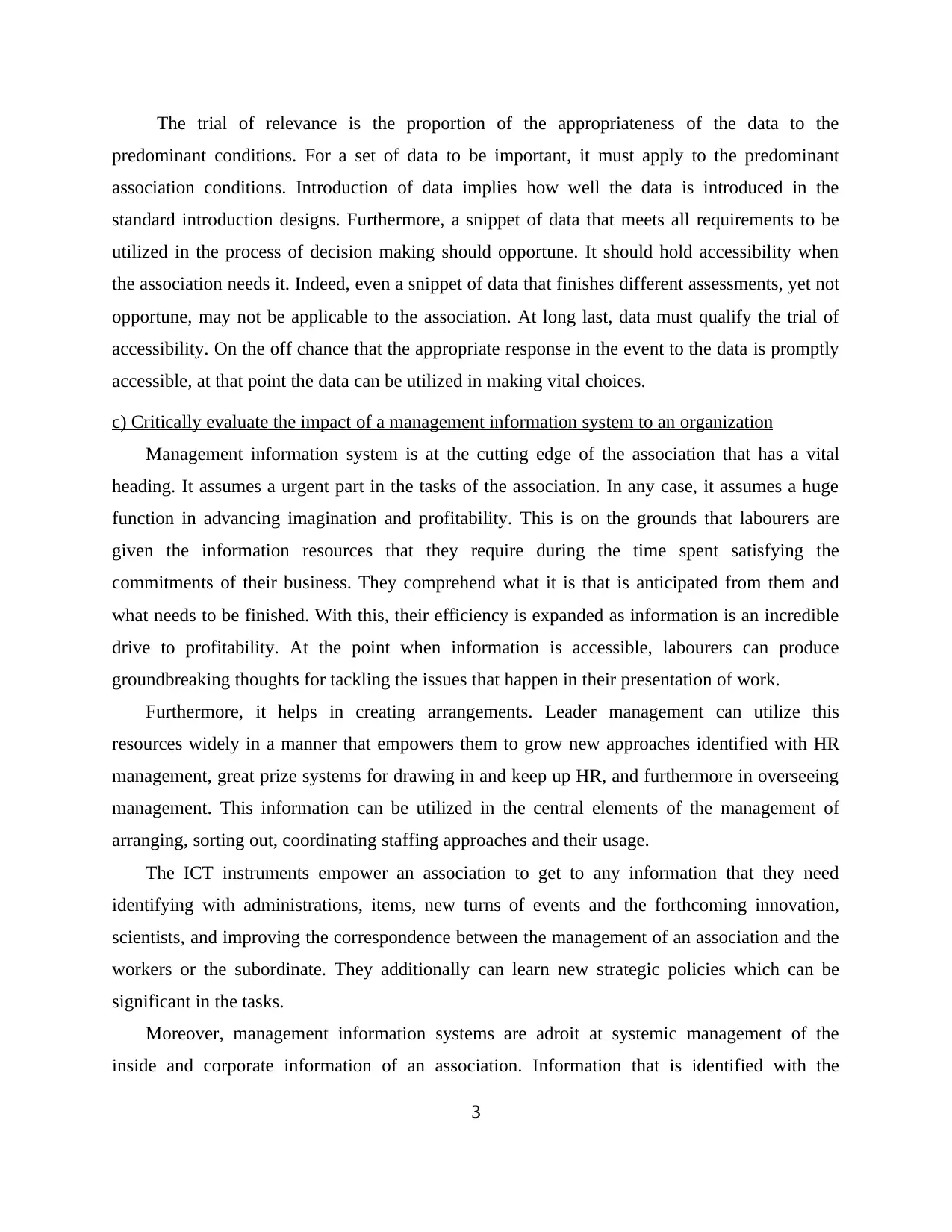
The trial of relevance is the proportion of the appropriateness of the data to the
predominant conditions. For a set of data to be important, it must apply to the predominant
association conditions. Introduction of data implies how well the data is introduced in the
standard introduction designs. Furthermore, a snippet of data that meets all requirements to be
utilized in the process of decision making should opportune. It should hold accessibility when
the association needs it. Indeed, even a snippet of data that finishes different assessments, yet not
opportune, may not be applicable to the association. At long last, data must qualify the trial of
accessibility. On the off chance that the appropriate response in the event to the data is promptly
accessible, at that point the data can be utilized in making vital choices.
c) Critically evaluate the impact of a management information system to an organization
Management information system is at the cutting edge of the association that has a vital
heading. It assumes a urgent part in the tasks of the association. In any case, it assumes a huge
function in advancing imagination and profitability. This is on the grounds that labourers are
given the information resources that they require during the time spent satisfying the
commitments of their business. They comprehend what it is that is anticipated from them and
what needs to be finished. With this, their efficiency is expanded as information is an incredible
drive to profitability. At the point when information is accessible, labourers can produce
groundbreaking thoughts for tackling the issues that happen in their presentation of work.
Furthermore, it helps in creating arrangements. Leader management can utilize this
resources widely in a manner that empowers them to grow new approaches identified with HR
management, great prize systems for drawing in and keep up HR, and furthermore in overseeing
management. This information can be utilized in the central elements of the management of
arranging, sorting out, coordinating staffing approaches and their usage.
The ICT instruments empower an association to get to any information that they need
identifying with administrations, items, new turns of events and the forthcoming innovation,
scientists, and improving the correspondence between the management of an association and the
workers or the subordinate. They additionally can learn new strategic policies which can be
significant in the tasks.
Moreover, management information systems are adroit at systemic management of the
inside and corporate information of an association. Information that is identified with the
3
predominant conditions. For a set of data to be important, it must apply to the predominant
association conditions. Introduction of data implies how well the data is introduced in the
standard introduction designs. Furthermore, a snippet of data that meets all requirements to be
utilized in the process of decision making should opportune. It should hold accessibility when
the association needs it. Indeed, even a snippet of data that finishes different assessments, yet not
opportune, may not be applicable to the association. At long last, data must qualify the trial of
accessibility. On the off chance that the appropriate response in the event to the data is promptly
accessible, at that point the data can be utilized in making vital choices.
c) Critically evaluate the impact of a management information system to an organization
Management information system is at the cutting edge of the association that has a vital
heading. It assumes a urgent part in the tasks of the association. In any case, it assumes a huge
function in advancing imagination and profitability. This is on the grounds that labourers are
given the information resources that they require during the time spent satisfying the
commitments of their business. They comprehend what it is that is anticipated from them and
what needs to be finished. With this, their efficiency is expanded as information is an incredible
drive to profitability. At the point when information is accessible, labourers can produce
groundbreaking thoughts for tackling the issues that happen in their presentation of work.
Furthermore, it helps in creating arrangements. Leader management can utilize this
resources widely in a manner that empowers them to grow new approaches identified with HR
management, great prize systems for drawing in and keep up HR, and furthermore in overseeing
management. This information can be utilized in the central elements of the management of
arranging, sorting out, coordinating staffing approaches and their usage.
The ICT instruments empower an association to get to any information that they need
identifying with administrations, items, new turns of events and the forthcoming innovation,
scientists, and improving the correspondence between the management of an association and the
workers or the subordinate. They additionally can learn new strategic policies which can be
significant in the tasks.
Moreover, management information systems are adroit at systemic management of the
inside and corporate information of an association. Information that is identified with the
3
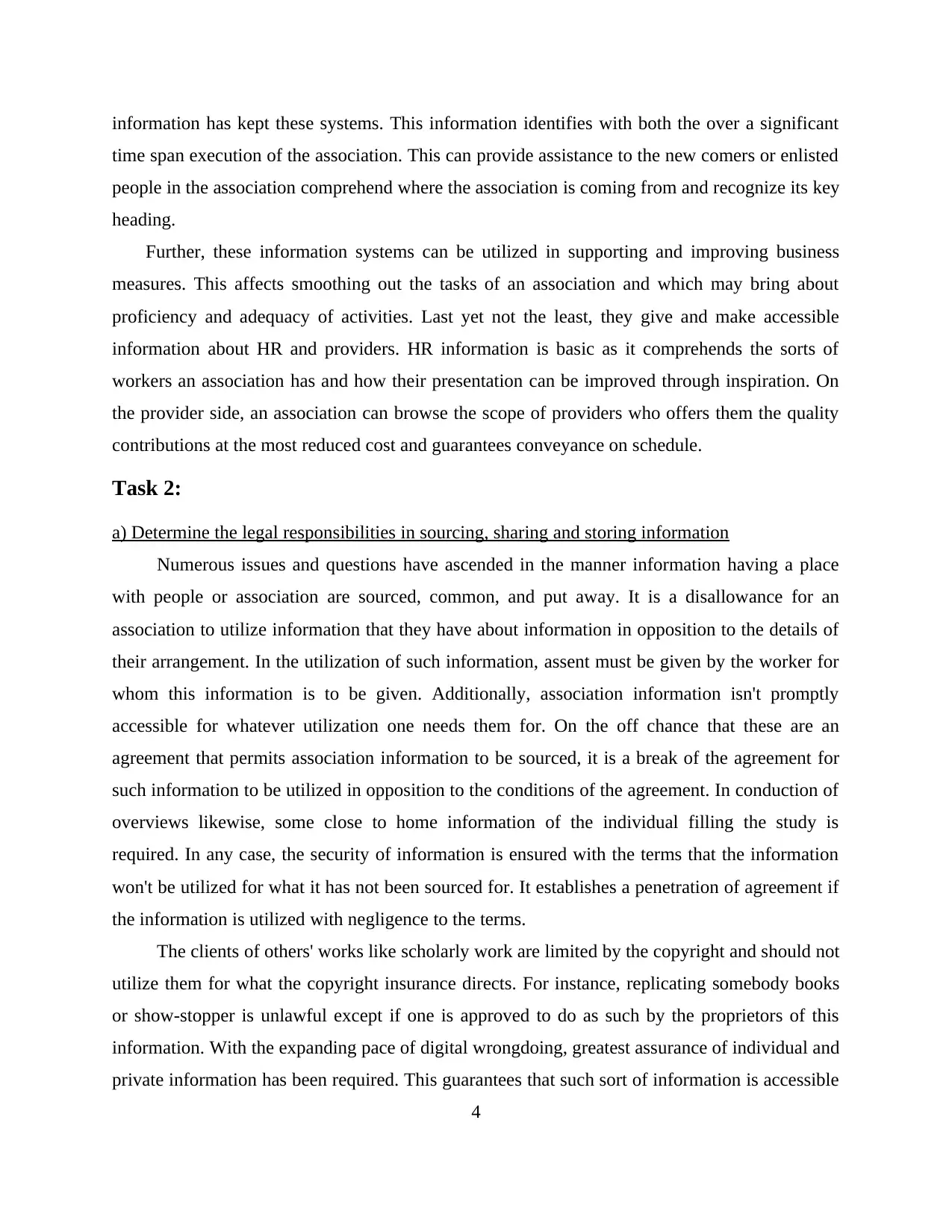
information has kept these systems. This information identifies with both the over a significant
time span execution of the association. This can provide assistance to the new comers or enlisted
people in the association comprehend where the association is coming from and recognize its key
heading.
Further, these information systems can be utilized in supporting and improving business
measures. This affects smoothing out the tasks of an association and which may bring about
proficiency and adequacy of activities. Last yet not the least, they give and make accessible
information about HR and providers. HR information is basic as it comprehends the sorts of
workers an association has and how their presentation can be improved through inspiration. On
the provider side, an association can browse the scope of providers who offers them the quality
contributions at the most reduced cost and guarantees conveyance on schedule.
Task 2:
a) Determine the legal responsibilities in sourcing, sharing and storing information
Numerous issues and questions have ascended in the manner information having a place
with people or association are sourced, common, and put away. It is a disallowance for an
association to utilize information that they have about information in opposition to the details of
their arrangement. In the utilization of such information, assent must be given by the worker for
whom this information is to be given. Additionally, association information isn't promptly
accessible for whatever utilization one needs them for. On the off chance that these are an
agreement that permits association information to be sourced, it is a break of the agreement for
such information to be utilized in opposition to the conditions of the agreement. In conduction of
overviews likewise, some close to home information of the individual filling the study is
required. In any case, the security of information is ensured with the terms that the information
won't be utilized for what it has not been sourced for. It establishes a penetration of agreement if
the information is utilized with negligence to the terms.
The clients of others' works like scholarly work are limited by the copyright and should not
utilize them for what the copyright insurance directs. For instance, replicating somebody books
or show-stopper is unlawful except if one is approved to do as such by the proprietors of this
information. With the expanding pace of digital wrongdoing, greatest assurance of individual and
private information has been required. This guarantees that such sort of information is accessible
4
time span execution of the association. This can provide assistance to the new comers or enlisted
people in the association comprehend where the association is coming from and recognize its key
heading.
Further, these information systems can be utilized in supporting and improving business
measures. This affects smoothing out the tasks of an association and which may bring about
proficiency and adequacy of activities. Last yet not the least, they give and make accessible
information about HR and providers. HR information is basic as it comprehends the sorts of
workers an association has and how their presentation can be improved through inspiration. On
the provider side, an association can browse the scope of providers who offers them the quality
contributions at the most reduced cost and guarantees conveyance on schedule.
Task 2:
a) Determine the legal responsibilities in sourcing, sharing and storing information
Numerous issues and questions have ascended in the manner information having a place
with people or association are sourced, common, and put away. It is a disallowance for an
association to utilize information that they have about information in opposition to the details of
their arrangement. In the utilization of such information, assent must be given by the worker for
whom this information is to be given. Additionally, association information isn't promptly
accessible for whatever utilization one needs them for. On the off chance that these are an
agreement that permits association information to be sourced, it is a break of the agreement for
such information to be utilized in opposition to the conditions of the agreement. In conduction of
overviews likewise, some close to home information of the individual filling the study is
required. In any case, the security of information is ensured with the terms that the information
won't be utilized for what it has not been sourced for. It establishes a penetration of agreement if
the information is utilized with negligence to the terms.
The clients of others' works like scholarly work are limited by the copyright and should not
utilize them for what the copyright insurance directs. For instance, replicating somebody books
or show-stopper is unlawful except if one is approved to do as such by the proprietors of this
information. With the expanding pace of digital wrongdoing, greatest assurance of individual and
private information has been required. This guarantees that such sort of information is accessible
4
⊘ This is a preview!⊘
Do you want full access?
Subscribe today to unlock all pages.

Trusted by 1+ million students worldwide
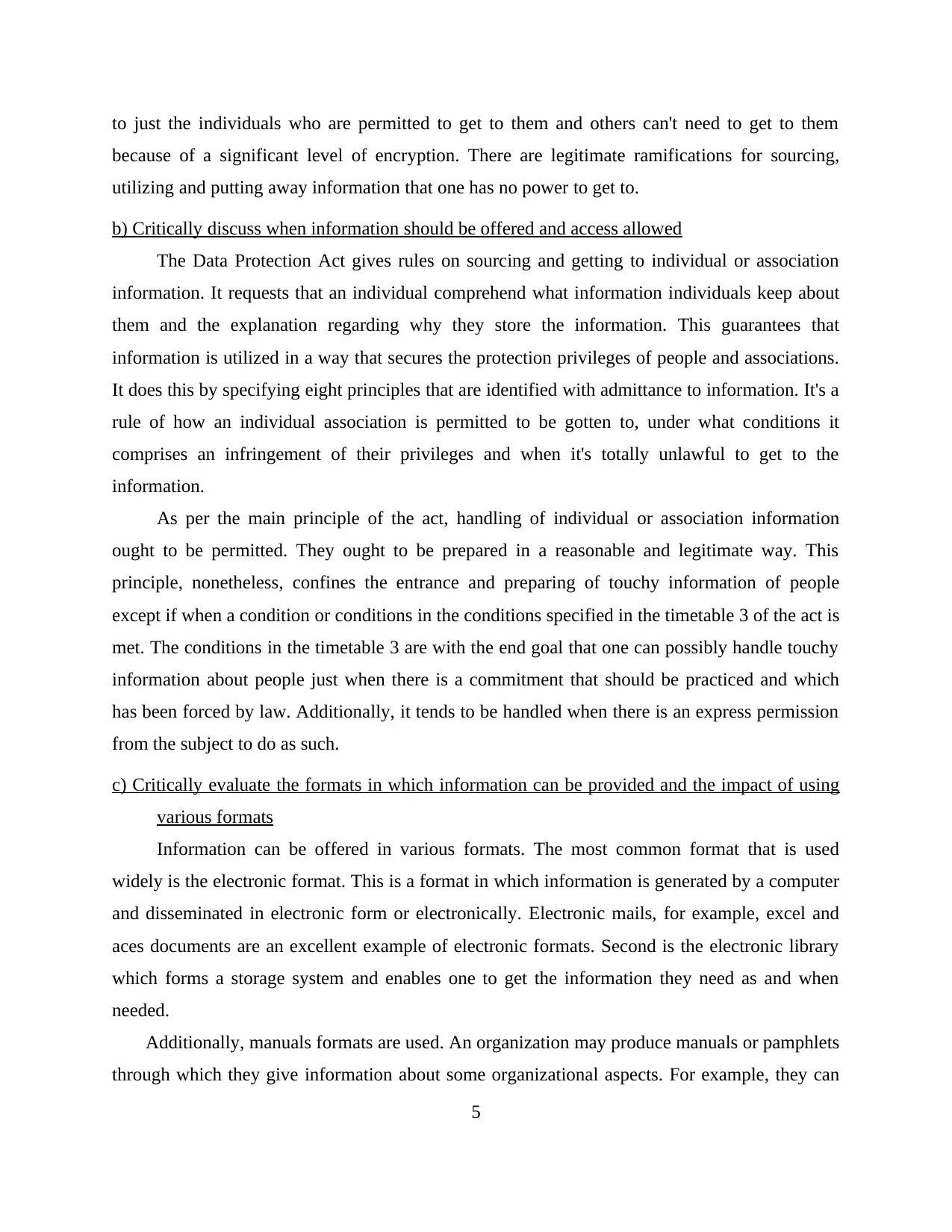
to just the individuals who are permitted to get to them and others can't need to get to them
because of a significant level of encryption. There are legitimate ramifications for sourcing,
utilizing and putting away information that one has no power to get to.
b) Critically discuss when information should be offered and access allowed
The Data Protection Act gives rules on sourcing and getting to individual or association
information. It requests that an individual comprehend what information individuals keep about
them and the explanation regarding why they store the information. This guarantees that
information is utilized in a way that secures the protection privileges of people and associations.
It does this by specifying eight principles that are identified with admittance to information. It's a
rule of how an individual association is permitted to be gotten to, under what conditions it
comprises an infringement of their privileges and when it's totally unlawful to get to the
information.
As per the main principle of the act, handling of individual or association information
ought to be permitted. They ought to be prepared in a reasonable and legitimate way. This
principle, nonetheless, confines the entrance and preparing of touchy information of people
except if when a condition or conditions in the conditions specified in the timetable 3 of the act is
met. The conditions in the timetable 3 are with the end goal that one can possibly handle touchy
information about people just when there is a commitment that should be practiced and which
has been forced by law. Additionally, it tends to be handled when there is an express permission
from the subject to do as such.
c) Critically evaluate the formats in which information can be provided and the impact of using
various formats
Information can be offered in various formats. The most common format that is used
widely is the electronic format. This is a format in which information is generated by a computer
and disseminated in electronic form or electronically. Electronic mails, for example, excel and
aces documents are an excellent example of electronic formats. Second is the electronic library
which forms a storage system and enables one to get the information they need as and when
needed.
Additionally, manuals formats are used. An organization may produce manuals or pamphlets
through which they give information about some organizational aspects. For example, they can
5
because of a significant level of encryption. There are legitimate ramifications for sourcing,
utilizing and putting away information that one has no power to get to.
b) Critically discuss when information should be offered and access allowed
The Data Protection Act gives rules on sourcing and getting to individual or association
information. It requests that an individual comprehend what information individuals keep about
them and the explanation regarding why they store the information. This guarantees that
information is utilized in a way that secures the protection privileges of people and associations.
It does this by specifying eight principles that are identified with admittance to information. It's a
rule of how an individual association is permitted to be gotten to, under what conditions it
comprises an infringement of their privileges and when it's totally unlawful to get to the
information.
As per the main principle of the act, handling of individual or association information
ought to be permitted. They ought to be prepared in a reasonable and legitimate way. This
principle, nonetheless, confines the entrance and preparing of touchy information of people
except if when a condition or conditions in the conditions specified in the timetable 3 of the act is
met. The conditions in the timetable 3 are with the end goal that one can possibly handle touchy
information about people just when there is a commitment that should be practiced and which
has been forced by law. Additionally, it tends to be handled when there is an express permission
from the subject to do as such.
c) Critically evaluate the formats in which information can be provided and the impact of using
various formats
Information can be offered in various formats. The most common format that is used
widely is the electronic format. This is a format in which information is generated by a computer
and disseminated in electronic form or electronically. Electronic mails, for example, excel and
aces documents are an excellent example of electronic formats. Second is the electronic library
which forms a storage system and enables one to get the information they need as and when
needed.
Additionally, manuals formats are used. An organization may produce manuals or pamphlets
through which they give information about some organizational aspects. For example, they can
5
Paraphrase This Document
Need a fresh take? Get an instant paraphrase of this document with our AI Paraphraser
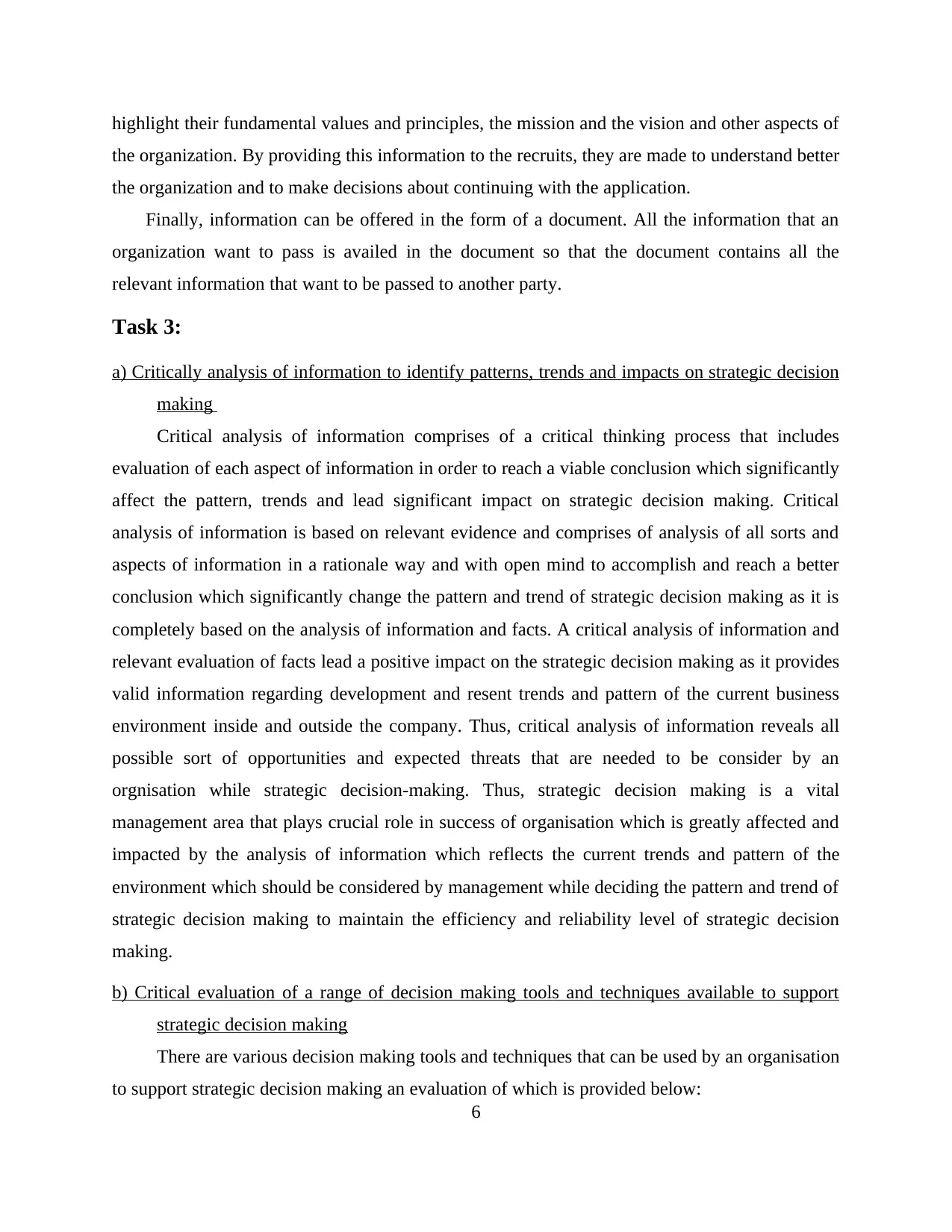
highlight their fundamental values and principles, the mission and the vision and other aspects of
the organization. By providing this information to the recruits, they are made to understand better
the organization and to make decisions about continuing with the application.
Finally, information can be offered in the form of a document. All the information that an
organization want to pass is availed in the document so that the document contains all the
relevant information that want to be passed to another party.
Task 3:
a) Critically analysis of information to identify patterns, trends and impacts on strategic decision
making
Critical analysis of information comprises of a critical thinking process that includes
evaluation of each aspect of information in order to reach a viable conclusion which significantly
affect the pattern, trends and lead significant impact on strategic decision making. Critical
analysis of information is based on relevant evidence and comprises of analysis of all sorts and
aspects of information in a rationale way and with open mind to accomplish and reach a better
conclusion which significantly change the pattern and trend of strategic decision making as it is
completely based on the analysis of information and facts. A critical analysis of information and
relevant evaluation of facts lead a positive impact on the strategic decision making as it provides
valid information regarding development and resent trends and pattern of the current business
environment inside and outside the company. Thus, critical analysis of information reveals all
possible sort of opportunities and expected threats that are needed to be consider by an
orgnisation while strategic decision-making. Thus, strategic decision making is a vital
management area that plays crucial role in success of organisation which is greatly affected and
impacted by the analysis of information which reflects the current trends and pattern of the
environment which should be considered by management while deciding the pattern and trend of
strategic decision making to maintain the efficiency and reliability level of strategic decision
making.
b) Critical evaluation of a range of decision making tools and techniques available to support
strategic decision making
There are various decision making tools and techniques that can be used by an organisation
to support strategic decision making an evaluation of which is provided below:
6
the organization. By providing this information to the recruits, they are made to understand better
the organization and to make decisions about continuing with the application.
Finally, information can be offered in the form of a document. All the information that an
organization want to pass is availed in the document so that the document contains all the
relevant information that want to be passed to another party.
Task 3:
a) Critically analysis of information to identify patterns, trends and impacts on strategic decision
making
Critical analysis of information comprises of a critical thinking process that includes
evaluation of each aspect of information in order to reach a viable conclusion which significantly
affect the pattern, trends and lead significant impact on strategic decision making. Critical
analysis of information is based on relevant evidence and comprises of analysis of all sorts and
aspects of information in a rationale way and with open mind to accomplish and reach a better
conclusion which significantly change the pattern and trend of strategic decision making as it is
completely based on the analysis of information and facts. A critical analysis of information and
relevant evaluation of facts lead a positive impact on the strategic decision making as it provides
valid information regarding development and resent trends and pattern of the current business
environment inside and outside the company. Thus, critical analysis of information reveals all
possible sort of opportunities and expected threats that are needed to be consider by an
orgnisation while strategic decision-making. Thus, strategic decision making is a vital
management area that plays crucial role in success of organisation which is greatly affected and
impacted by the analysis of information which reflects the current trends and pattern of the
environment which should be considered by management while deciding the pattern and trend of
strategic decision making to maintain the efficiency and reliability level of strategic decision
making.
b) Critical evaluation of a range of decision making tools and techniques available to support
strategic decision making
There are various decision making tools and techniques that can be used by an organisation
to support strategic decision making an evaluation of which is provided below:
6
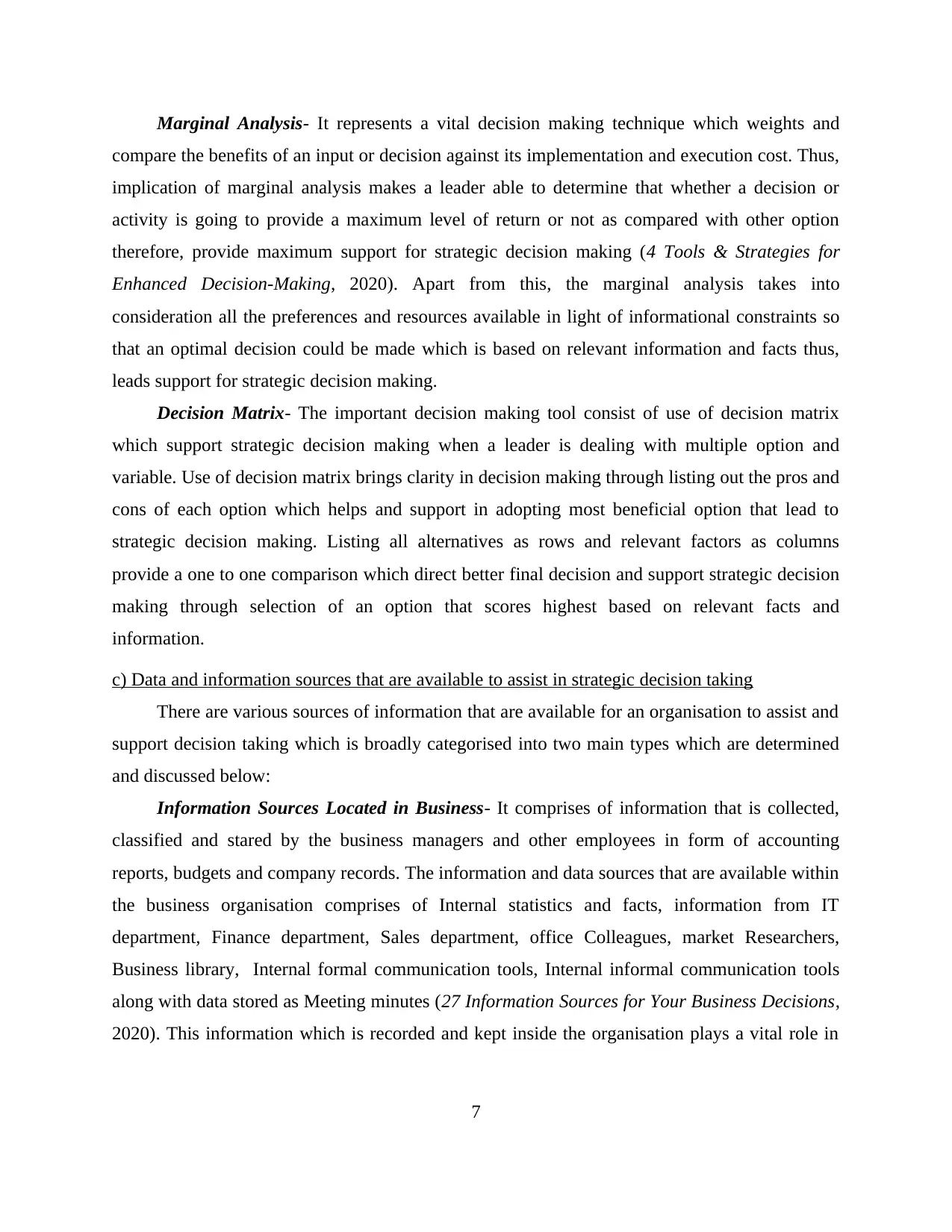
Marginal Analysis- It represents a vital decision making technique which weights and
compare the benefits of an input or decision against its implementation and execution cost. Thus,
implication of marginal analysis makes a leader able to determine that whether a decision or
activity is going to provide a maximum level of return or not as compared with other option
therefore, provide maximum support for strategic decision making (4 Tools & Strategies for
Enhanced Decision-Making, 2020). Apart from this, the marginal analysis takes into
consideration all the preferences and resources available in light of informational constraints so
that an optimal decision could be made which is based on relevant information and facts thus,
leads support for strategic decision making.
Decision Matrix- The important decision making tool consist of use of decision matrix
which support strategic decision making when a leader is dealing with multiple option and
variable. Use of decision matrix brings clarity in decision making through listing out the pros and
cons of each option which helps and support in adopting most beneficial option that lead to
strategic decision making. Listing all alternatives as rows and relevant factors as columns
provide a one to one comparison which direct better final decision and support strategic decision
making through selection of an option that scores highest based on relevant facts and
information.
c) Data and information sources that are available to assist in strategic decision taking
There are various sources of information that are available for an organisation to assist and
support decision taking which is broadly categorised into two main types which are determined
and discussed below:
Information Sources Located in Business- It comprises of information that is collected,
classified and stared by the business managers and other employees in form of accounting
reports, budgets and company records. The information and data sources that are available within
the business organisation comprises of Internal statistics and facts, information from IT
department, Finance department, Sales department, office Colleagues, market Researchers,
Business library, Internal formal communication tools, Internal informal communication tools
along with data stored as Meeting minutes (27 Information Sources for Your Business Decisions,
2020). This information which is recorded and kept inside the organisation plays a vital role in
7
compare the benefits of an input or decision against its implementation and execution cost. Thus,
implication of marginal analysis makes a leader able to determine that whether a decision or
activity is going to provide a maximum level of return or not as compared with other option
therefore, provide maximum support for strategic decision making (4 Tools & Strategies for
Enhanced Decision-Making, 2020). Apart from this, the marginal analysis takes into
consideration all the preferences and resources available in light of informational constraints so
that an optimal decision could be made which is based on relevant information and facts thus,
leads support for strategic decision making.
Decision Matrix- The important decision making tool consist of use of decision matrix
which support strategic decision making when a leader is dealing with multiple option and
variable. Use of decision matrix brings clarity in decision making through listing out the pros and
cons of each option which helps and support in adopting most beneficial option that lead to
strategic decision making. Listing all alternatives as rows and relevant factors as columns
provide a one to one comparison which direct better final decision and support strategic decision
making through selection of an option that scores highest based on relevant facts and
information.
c) Data and information sources that are available to assist in strategic decision taking
There are various sources of information that are available for an organisation to assist and
support decision taking which is broadly categorised into two main types which are determined
and discussed below:
Information Sources Located in Business- It comprises of information that is collected,
classified and stared by the business managers and other employees in form of accounting
reports, budgets and company records. The information and data sources that are available within
the business organisation comprises of Internal statistics and facts, information from IT
department, Finance department, Sales department, office Colleagues, market Researchers,
Business library, Internal formal communication tools, Internal informal communication tools
along with data stored as Meeting minutes (27 Information Sources for Your Business Decisions,
2020). This information which is recorded and kept inside the organisation plays a vital role in
7
⊘ This is a preview!⊘
Do you want full access?
Subscribe today to unlock all pages.

Trusted by 1+ million students worldwide
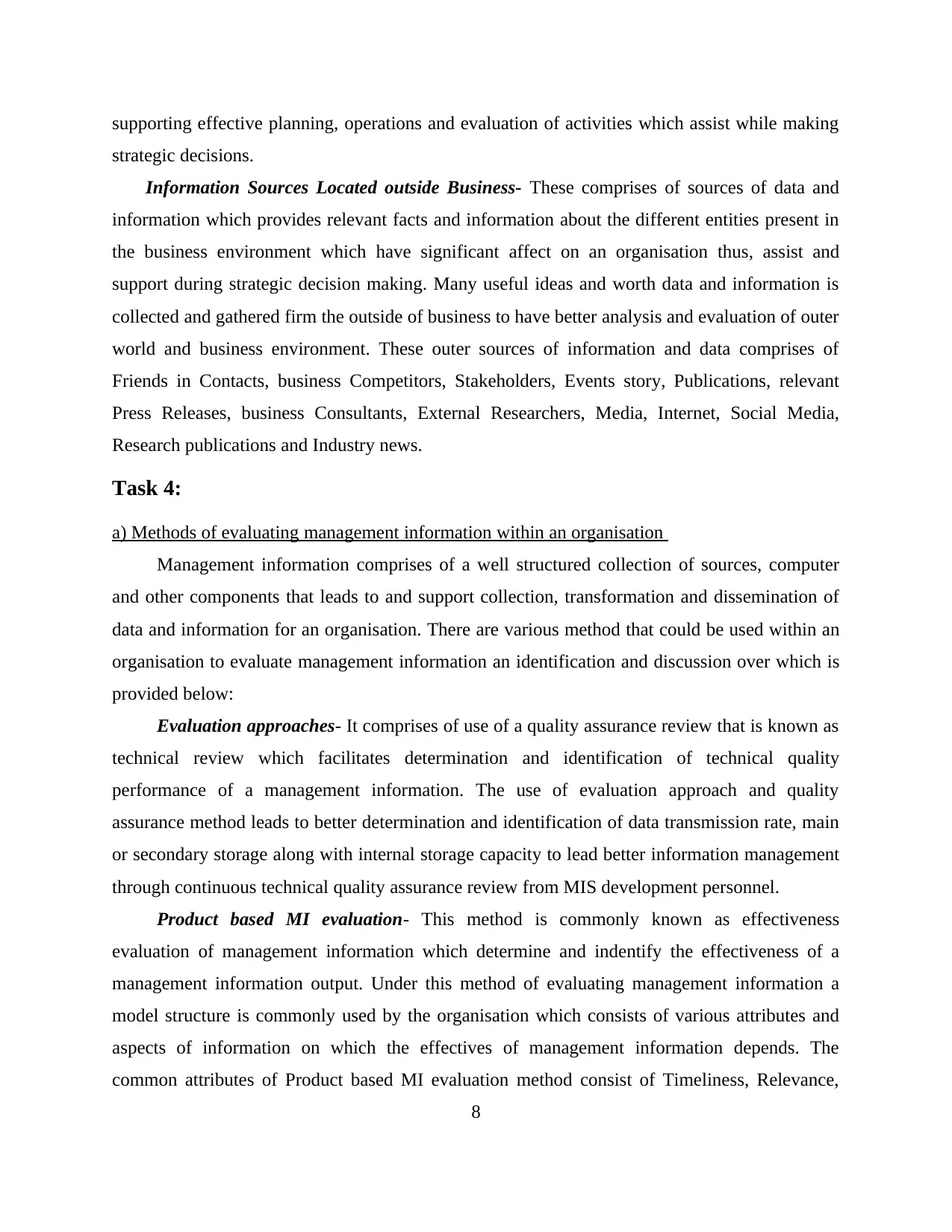
supporting effective planning, operations and evaluation of activities which assist while making
strategic decisions.
Information Sources Located outside Business- These comprises of sources of data and
information which provides relevant facts and information about the different entities present in
the business environment which have significant affect on an organisation thus, assist and
support during strategic decision making. Many useful ideas and worth data and information is
collected and gathered firm the outside of business to have better analysis and evaluation of outer
world and business environment. These outer sources of information and data comprises of
Friends in Contacts, business Competitors, Stakeholders, Events story, Publications, relevant
Press Releases, business Consultants, External Researchers, Media, Internet, Social Media,
Research publications and Industry news.
Task 4:
a) Methods of evaluating management information within an organisation
Management information comprises of a well structured collection of sources, computer
and other components that leads to and support collection, transformation and dissemination of
data and information for an organisation. There are various method that could be used within an
organisation to evaluate management information an identification and discussion over which is
provided below:
Evaluation approaches- It comprises of use of a quality assurance review that is known as
technical review which facilitates determination and identification of technical quality
performance of a management information. The use of evaluation approach and quality
assurance method leads to better determination and identification of data transmission rate, main
or secondary storage along with internal storage capacity to lead better information management
through continuous technical quality assurance review from MIS development personnel.
Product based MI evaluation- This method is commonly known as effectiveness
evaluation of management information which determine and indentify the effectiveness of a
management information output. Under this method of evaluating management information a
model structure is commonly used by the organisation which consists of various attributes and
aspects of information on which the effectives of management information depends. The
common attributes of Product based MI evaluation method consist of Timeliness, Relevance,
8
strategic decisions.
Information Sources Located outside Business- These comprises of sources of data and
information which provides relevant facts and information about the different entities present in
the business environment which have significant affect on an organisation thus, assist and
support during strategic decision making. Many useful ideas and worth data and information is
collected and gathered firm the outside of business to have better analysis and evaluation of outer
world and business environment. These outer sources of information and data comprises of
Friends in Contacts, business Competitors, Stakeholders, Events story, Publications, relevant
Press Releases, business Consultants, External Researchers, Media, Internet, Social Media,
Research publications and Industry news.
Task 4:
a) Methods of evaluating management information within an organisation
Management information comprises of a well structured collection of sources, computer
and other components that leads to and support collection, transformation and dissemination of
data and information for an organisation. There are various method that could be used within an
organisation to evaluate management information an identification and discussion over which is
provided below:
Evaluation approaches- It comprises of use of a quality assurance review that is known as
technical review which facilitates determination and identification of technical quality
performance of a management information. The use of evaluation approach and quality
assurance method leads to better determination and identification of data transmission rate, main
or secondary storage along with internal storage capacity to lead better information management
through continuous technical quality assurance review from MIS development personnel.
Product based MI evaluation- This method is commonly known as effectiveness
evaluation of management information which determine and indentify the effectiveness of a
management information output. Under this method of evaluating management information a
model structure is commonly used by the organisation which consists of various attributes and
aspects of information on which the effectives of management information depends. The
common attributes of Product based MI evaluation method consist of Timeliness, Relevance,
8
Paraphrase This Document
Need a fresh take? Get an instant paraphrase of this document with our AI Paraphraser
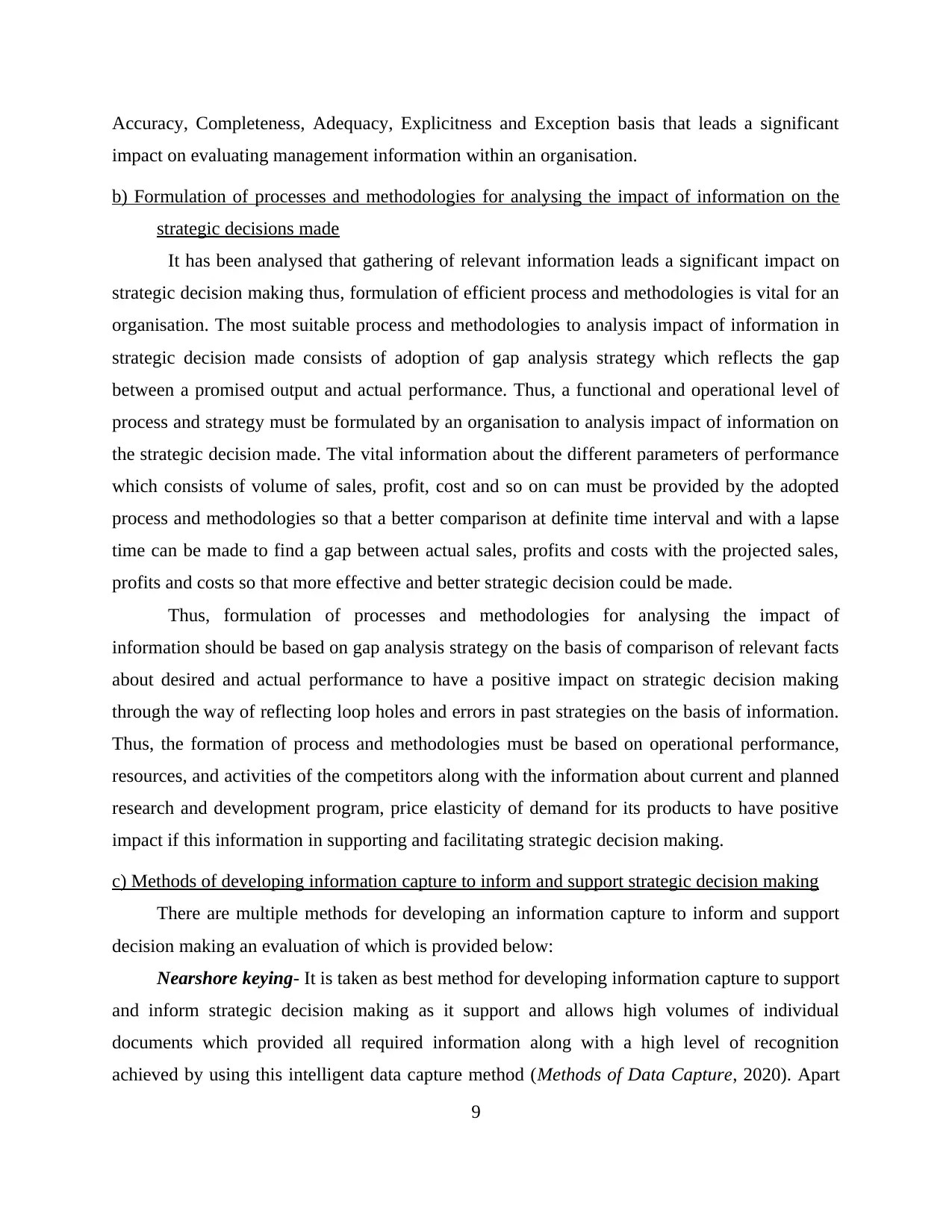
Accuracy, Completeness, Adequacy, Explicitness and Exception basis that leads a significant
impact on evaluating management information within an organisation.
b) Formulation of processes and methodologies for analysing the impact of information on the
strategic decisions made
It has been analysed that gathering of relevant information leads a significant impact on
strategic decision making thus, formulation of efficient process and methodologies is vital for an
organisation. The most suitable process and methodologies to analysis impact of information in
strategic decision made consists of adoption of gap analysis strategy which reflects the gap
between a promised output and actual performance. Thus, a functional and operational level of
process and strategy must be formulated by an organisation to analysis impact of information on
the strategic decision made. The vital information about the different parameters of performance
which consists of volume of sales, profit, cost and so on can must be provided by the adopted
process and methodologies so that a better comparison at definite time interval and with a lapse
time can be made to find a gap between actual sales, profits and costs with the projected sales,
profits and costs so that more effective and better strategic decision could be made.
Thus, formulation of processes and methodologies for analysing the impact of
information should be based on gap analysis strategy on the basis of comparison of relevant facts
about desired and actual performance to have a positive impact on strategic decision making
through the way of reflecting loop holes and errors in past strategies on the basis of information.
Thus, the formation of process and methodologies must be based on operational performance,
resources, and activities of the competitors along with the information about current and planned
research and development program, price elasticity of demand for its products to have positive
impact if this information in supporting and facilitating strategic decision making.
c) Methods of developing information capture to inform and support strategic decision making
There are multiple methods for developing an information capture to inform and support
decision making an evaluation of which is provided below:
Nearshore keying- It is taken as best method for developing information capture to support
and inform strategic decision making as it support and allows high volumes of individual
documents which provided all required information along with a high level of recognition
achieved by using this intelligent data capture method (Methods of Data Capture, 2020). Apart
9
impact on evaluating management information within an organisation.
b) Formulation of processes and methodologies for analysing the impact of information on the
strategic decisions made
It has been analysed that gathering of relevant information leads a significant impact on
strategic decision making thus, formulation of efficient process and methodologies is vital for an
organisation. The most suitable process and methodologies to analysis impact of information in
strategic decision made consists of adoption of gap analysis strategy which reflects the gap
between a promised output and actual performance. Thus, a functional and operational level of
process and strategy must be formulated by an organisation to analysis impact of information on
the strategic decision made. The vital information about the different parameters of performance
which consists of volume of sales, profit, cost and so on can must be provided by the adopted
process and methodologies so that a better comparison at definite time interval and with a lapse
time can be made to find a gap between actual sales, profits and costs with the projected sales,
profits and costs so that more effective and better strategic decision could be made.
Thus, formulation of processes and methodologies for analysing the impact of
information should be based on gap analysis strategy on the basis of comparison of relevant facts
about desired and actual performance to have a positive impact on strategic decision making
through the way of reflecting loop holes and errors in past strategies on the basis of information.
Thus, the formation of process and methodologies must be based on operational performance,
resources, and activities of the competitors along with the information about current and planned
research and development program, price elasticity of demand for its products to have positive
impact if this information in supporting and facilitating strategic decision making.
c) Methods of developing information capture to inform and support strategic decision making
There are multiple methods for developing an information capture to inform and support
decision making an evaluation of which is provided below:
Nearshore keying- It is taken as best method for developing information capture to support
and inform strategic decision making as it support and allows high volumes of individual
documents which provided all required information along with a high level of recognition
achieved by using this intelligent data capture method (Methods of Data Capture, 2020). Apart
9
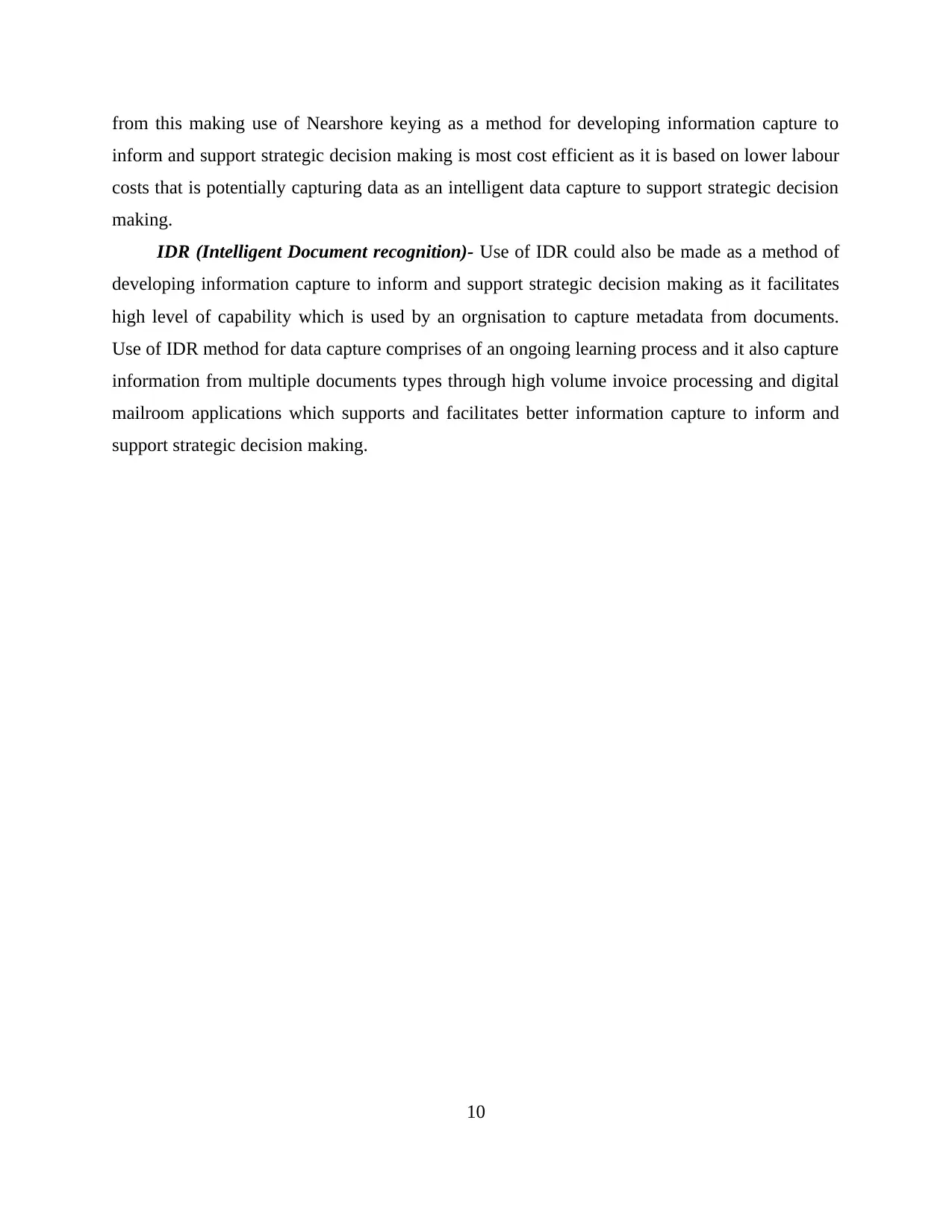
from this making use of Nearshore keying as a method for developing information capture to
inform and support strategic decision making is most cost efficient as it is based on lower labour
costs that is potentially capturing data as an intelligent data capture to support strategic decision
making.
IDR (Intelligent Document recognition)- Use of IDR could also be made as a method of
developing information capture to inform and support strategic decision making as it facilitates
high level of capability which is used by an orgnisation to capture metadata from documents.
Use of IDR method for data capture comprises of an ongoing learning process and it also capture
information from multiple documents types through high volume invoice processing and digital
mailroom applications which supports and facilitates better information capture to inform and
support strategic decision making.
10
inform and support strategic decision making is most cost efficient as it is based on lower labour
costs that is potentially capturing data as an intelligent data capture to support strategic decision
making.
IDR (Intelligent Document recognition)- Use of IDR could also be made as a method of
developing information capture to inform and support strategic decision making as it facilitates
high level of capability which is used by an orgnisation to capture metadata from documents.
Use of IDR method for data capture comprises of an ongoing learning process and it also capture
information from multiple documents types through high volume invoice processing and digital
mailroom applications which supports and facilitates better information capture to inform and
support strategic decision making.
10
⊘ This is a preview!⊘
Do you want full access?
Subscribe today to unlock all pages.

Trusted by 1+ million students worldwide
1 out of 14
Related Documents
Your All-in-One AI-Powered Toolkit for Academic Success.
+13062052269
info@desklib.com
Available 24*7 on WhatsApp / Email
![[object Object]](/_next/static/media/star-bottom.7253800d.svg)
Unlock your academic potential
Copyright © 2020–2025 A2Z Services. All Rights Reserved. Developed and managed by ZUCOL.




